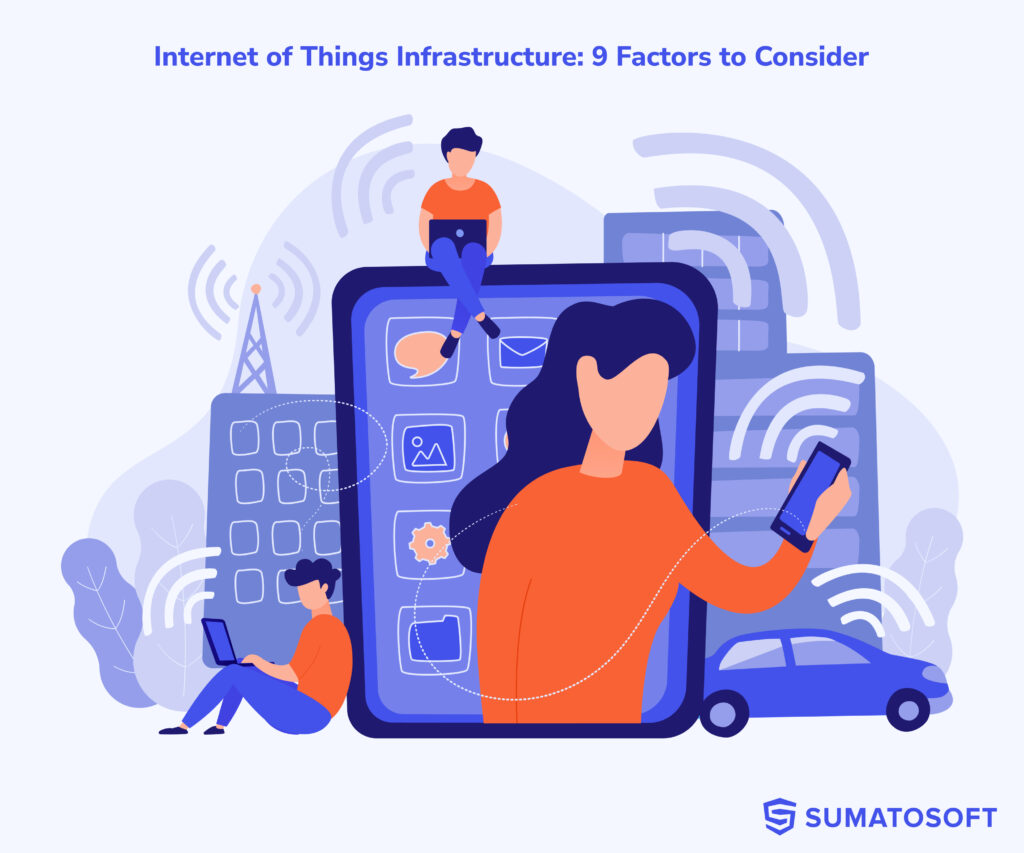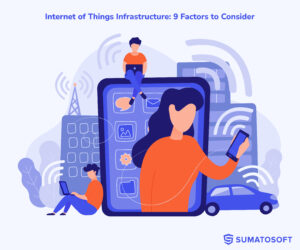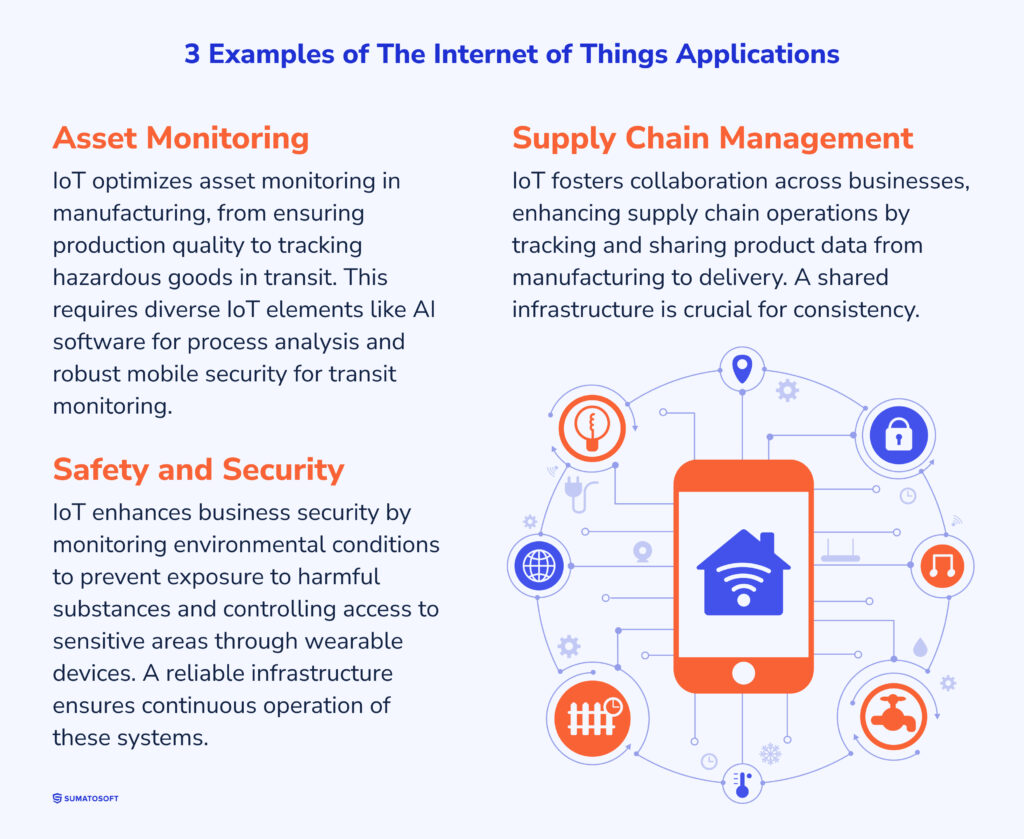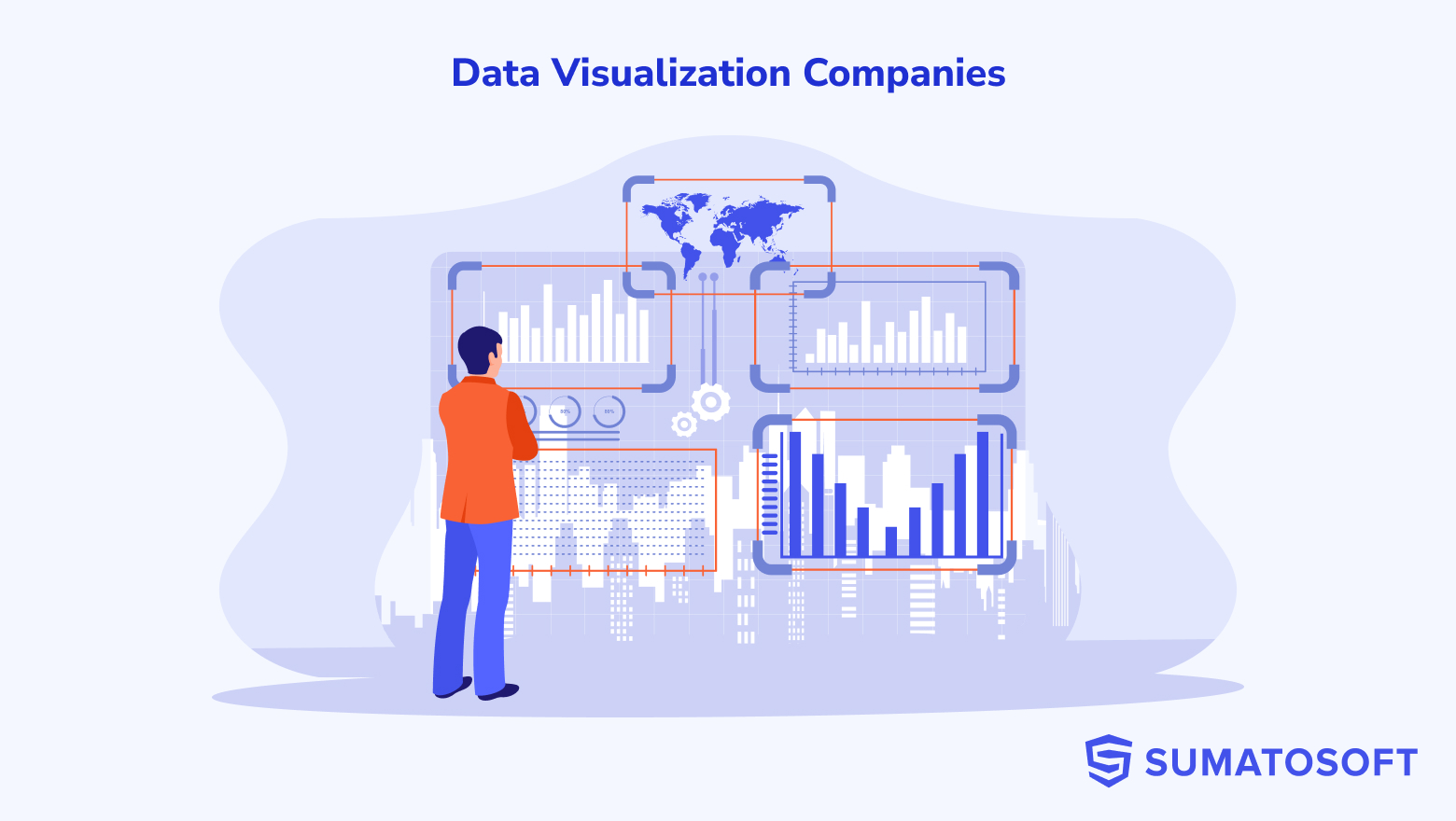Internet of Things (IoT) Infrastructure: 9 Factors to Consider


Autonomous car.
Delivery drones.
Manufacturing 4.0.
Smartwatches.
Smart cities.
It’s IoT that has made this possible.
The Internet of Things is indeed an amazing technology that has already demonstrated a great impact on businesses and economies. However, success requires huge efforts and investments.
According to a recent joint report from the University of South Florida and Universidade NOVA de Lisboa, there are multiple challenges to overcome wen integrating IoT into any organization. Some of them include significant security and privacy issues, comprehensive systems design, and effective collaboration with artificial intelligence (AI) tools.
As an IoT development provider, we’re excited to play a role in building this future.
In this article, I will describe essential IoT components to consider when constructing your IoT infrastructure. We’ll dedicate some time to giving you a deeper understanding of the core components and the challenges you’ll need to tackle.
What Is the Internet of Things
People generally tend to understand the Internet of Things as a group of connected devices. This is true as the most basic definition. However, it also isn’t this pretty simple. The IoT represents different things depending on who intends to utilize it. This is vital knowledge from an IoT infrastructure standpoint, as the user will determine the elements you need to include in your support system. As such, you need to consider that the IoT is broken down into 2 core types: consumer and industrial.
The first type is consumer IoT, also known as CIoT. The devices in this particular ecosystem are usually focused on providing convenience and quality-of-life improvements for individual private users. This often includes consumer gadgets like smart refrigerators, smart lighting systems, and wearable technology. The CIoT also tends to be less data-heavy, although this can vary from user to user. While the CIoT is still subject to security risks, the scope for disruption also tends to be relatively limited.
The second type is industrial IoT, which is more commonly termed IIoT. The intention of the IIoT tends to be centered on improving the efficiency and efficacy of business operations. These devices are designed to capture, analyze, and interpret industrial intelligence, so business leaders can make real-time process adjustments. Increasingly, the IIoT is adopted to support safety in the workplace. As such, one of the essential roles of IoT infrastructure in the industry is to prevent disruptions that could result in heightened risks to employees and operations.
What Forms the Backbone of the IoT

Before you buy devices or start developing software for your device network, it’s necessary to understand what forms the backbone of IoT which is internet connectivity. Why? The IoT system needs enough coverage and bandwidth to facilitate uninterrupted data transmission devices to the cloud.
In consumer IoT, Wi-Fi is typically the go-to choice for internet connectivity in the IoT ecosystem, and a small-business IoT setup can connect via Wi-Fi as well. The hub for devices contains a Wi-Fi chip; devices communicate via Wi-Fi, and all connected devices form a local area network that communicates with a central server, typically on a 4G network. Besides Wi-Fi, Bluetooth is also becoming a popular CIoT choice to connect devices to a mobile network.
For industrial IoT, you need the internet with more bandwidth to transfer massive amounts of data from gateways to the cloud. Likewise, upload and download speeds must be fast. Otherwise, the system won’t work efficiently. Fiber optic cable and 5G are the best types of the internet for IIoT, with fiber offering unlimited bandwidth and breakneck speeds. In comparison, 5G promises low latency and connectivity for 1 million or more devices per square mile.
3 Examples of The Internet of Things Applications

In order to build the most appropriate IoT infrastructure, you also need to consider what you intend to utilize it for. There are multiple applications for the IoT and each has its own requirements to function effectively. Facilities management tools require specialized sensors and software, while quality control devices need protocols to capture both real-time production data and final consumer opinions. Getting the most out of your IoT infrastructure means making it suited for purpose.
There are plenty of specific IoT business ideas available. Additionally, your business can use the IoT to optimize operations. In that vein, here are 3 key applications to consider:
Asset Monitoring
One of the best use case of IoT in manufacturing is to use it to monitor company assets. This can apply in a range of ways. Firstly, sensors can track the details of the manufacturing process to ensure assets are created to the most efficient and high-quality standards. Sensors can also monitor hazardous or perishable goods during transit to maintain safe conditions. While each of these applications involves monitoring, they tend to require different elements of IoT infrastructure. For instance, on-site manufacturing sensors will need AI software to analyze processes. Transit monitoring will need effective mobile security protocols.
Supply Chain Management
Increasingly, the IoT is not simply being utilized to positively impact individual businesses. It has become a collaborative tool for companies to utilize across their partnership networks. The supply chain has been particularly enthusiastic in embracing it to seamlessly track and share key product data during manufacturing, warehousing, logistics, and delivery, no matter how many businesses are involved in the process. Naturally, this requires a shared infrastructure to keep protocols consistent across all businesses.
Safety and Security
Successful businesses are frequently subject to risks. Some of these will be the familiar cybercrime hazards of the digital landscape. Others will be physical in nature, such as unauthorized entry onto the work premises or employee health issues. One of the key applications for the IoT at the moment is bolstering safety and security. Sensors that monitor environmental conditions can help mitigate unnecessary toxicity exposure. Wearable devices can also control employee and visitor access to sensitive areas of the business. Solid infrastructure helps to ensure that these systems are constantly running and sharing information.
Energy Efficiency
The energy topic has always been a sensitive topic, but it became even more acute after the energy crises in 1970s and raising awareness about environmental degradation and climate change.
The Internet of Things makes a change here by optimizing energy management in smart buildings and homes, industrial facilities, precise farming, and through the usage of smart grids that balance energy supply and demand by automatically adjusting energy usage during peak times.
9 Factors to Consider While Building IoT Infrastructure

A solid IoT infrastructure depends on the success of IoT architecture, as well as the strategy your business uses to convert data into intelligence and action.
Factor #1: IoT Systems Have 4 Main Components
Some of the finer points of IoT infrastructure may be individualized to meet the needs of your particular business or sector. Nevertheless, it is generally agreed that IoT systems have four main components. The elements of the infrastructure both include these components alongside other tools that help support and bolster them.
These components are:
Sensor Hardware
These are the physical devices that are the most visible aspects of the IoT infrastructure. Each of these devices will be fitted with at least one form of sensor or actuator. This enables the device to collect different types of key data that are integral to its purpose in the ecosystem of connected objects. Some of this is likely to be relatively basic data, such as atmospheric readings. Other devices, however, will have more sensitive hardware that allows them to capture more complex data points and directly interact with other onboard applications.
Connectivity
As we’ve mentioned previously, a device in the IoT is relatively useless unless it has some way to be connected to other devices or systems. As such, the device needs to have hardware and software elements that allow it to connect to either the wider company network or a shared cloud platform. Usually, this takes the form of Wi-Fi technology, particularly when data has to be transmitted on the move or across vast distances. However, on-premises sensors are also known to connect to the network via Bluetooth.
Data Processing
The data collected by the device usually isn’t in a consumable format on its own. To be understood and actionable, the data must be processed by a software platform. Here the synergy of IoT and Big Data comes into play. Increasingly, this is taking the form of AI systems that both analyze and interpret the data, comparing it to past internal and external data sets in order to make effective recommendations for activities. In some cases, this data processing element of IoT infrastructure will trigger automated actions when the information hits or exceeds certain parameters. For instance, the presence of hazardous chemicals over a certain level of toxicity may trip alarms or other warnings.
User Interfaces
The human element of the IoT is important. While many aspects may be automated, the intention is still usually that the technology is a collaborator with human staff. As such, to interact with both the data and the devices effectively, there needs to be an accessible user interface. In most cases, this will be a software application that is operated using a mobile device, such as a smartphone or a more specialist piece of industrial equipment. However, in some circumstances, the IoT device itself will also have a user interface.
Factor #2: The System Must Be Scalable

IoT infrastructure needs to be scalable in order to both ensure successful operations and a good return on investment. Scalability means adaptability — as your business grows, the system grows with it. You’ll need a software solution that makes it easy to add new users, features, and workloads. As new sensors come online, the infrastructure’s data acquisition system, IoT gateway, and edge computing technology must be able to interact seamlessly, transferring an increased volume of data to the cloud without freezing up or losing integrity.
Factor #3: Data Management Is Key
Data management comprises everything from data acquisition to transfer, aggregation, analysis, and application. In other words, your IoT infrastructure’s data management capabilities will make or break the system.
An essential part of data management that gained even more traction the recent years after ChatGPT’s introduction (see our article IoT trends 2024) is edge computing. In simple words, it’s processing the data on-site for AI and ML applications rather than transferring it to the cloud.
Edge computing allows enterprises to scale IoT systems and make good use of the data. The IoT gateways is the place where edge computing inhabits. Without edge computing, more sensors will simply mean more data transferred indiscriminately to the cloud. Data analytics software can tell you a lot about all that data, but latency becomes a big issue when machines should be using data to inform actions in real time. Edge devices operate close to point of acquisition, processing and analyzing data faster so it can be put to use quicker.
Meanwhile, the other piece of the data management puzzle takes place in the cloud, where the software you use must be able to communicate with edge devices and integrate with your business’s other systems.
Factor #4: Software Must Meet Your Business Needs
Picture your IoT software as the gray matter of the brain. Not only is it the primary seat of intelligence, where information becomes strategy, but it communicates with other parts of the brain as well. Those other parts of the brain are your business’s other software solutions. Your IoT software should be able to integrate with them based on your business needs.
For example, a smart hotel management system integrates with the hotel’s SMS and email providers. Therefore, you can view all automated systems data and guest communications in one place. This enables hoteliers to manage the entire operation from an easy interface. They can automate the night audit process and handle the whole reservation process — including guest information, check-ins, emails, and invoices — even as they view the status of things like smart thermostats and lighting. Your business can take advantage of this type of integrative software functionality to optimize operations when you’re building IoT infrastructure.
Factor #5: You Need a User-Friendly App
There’s hardly any point in building a customized IoT infrastructure if you don’t have an easy way for staff to interact with the system. That’s where a user-friendly app comes in. You need an accessible dashboard with which users can perform day-to-day tasks with ease.
Whether it’s enterprise resource planning, human resource management, or business intelligence, your app’s features should enable users to save time and get the most out of IoT data. On the backend, prioritize effective big data processing and analysis, as well as updates that maximize security. On the frontend, prioritize ease of use and features that fit your business operations.
Factor #6: AI Will Be a Game Changer
Artificial intelligence as part of IoT infrastructure promises to revolutionize business processes. In manufacturing, Deloitte found that predictive maintenance reduces maintenance costs by 5 to 10%, reducing the time it takes to schedule maintenance by up to 50%. Predictive maintenance is just one example of AI in IoT (AIoT), where machine learning algorithms analyze machine data to predict when and why a machine will break.
In edge computing, AI-powered edge devices can perform the intelligence functions you would normally see in the cloud. According to researchers who published their findings in IEEE Network Magazine, an “in-edge AI framework” is designed to “intelligently utilize the collaboration among devices and edge nodes.” This allows the system to optimize itself, implementing data intelligence insights and reducing unnecessary communication between devices and the cloud.
Factor #7: Every IoT System Has Unique System Requirements
Your network is a key part of your IoT infrastructure. It helps to ensure that all devices in the ecosystem connect in an effective and secure way. However, as with many other elements of the IoT, the requirements of your network will often need to be tailored to the industry you’re operating within.
For instance, the agriculture industry is continuing to embrace the advantages of lower-cost sensors to improve operations. However, the efficacy of smart farming relies on network infrastructure that can handle multiple simultaneous tasks. Indeed, with smart machinery and environmental monitoring involved, these tend to be data-rich tasks, too. As such, the network must be reliable, with contingencies in place to mitigate loss of connectivity. The network also must be able to store and share large volumes of data. Indeed, with automated tools taking care of precision agricultural tasks, the network connection must have minimal latency, which is usually achieved through 5G technology.
Factor #8: The IoT Requires Airtight Security Protocols
Among the most important aspects of IoT infrastructure consideration is your cybersecurity protocols. The risks of the digital landscape are not getting any less prevalent. Indeed, one of the mistakes businesses frequently make is in thinking that their IoT devices are not likely to be a target for cybercriminals. This is certainly not the case. Some hackers specifically seek out these devices because they know that there is valuable data being shared that too many business leaders leave unprotected.
The most basic IoT security consideration you need to attend to is strong password protocols across your network. There should be no device or application that isn’t protected by a complex and regularly changed password. Wherever possible, make certain that these are subject to multi-factor authentication protocols.
Importantly, review the onboard security of each piece of your IoT architecture. It doesn’t matter how strong your passwords are to your network, if an IoT device is breached, this can act as a bridge to all other areas. The first step upon introducing a device to your network is changing the default password and making certain the full encryption settings are activated.
Factor #9: Continuous Monitoring and Maintenance
A crucial, yet often neglected aspect while building an IoT infrastructure is the continuous monitoring and maintenance of the system. This is necessary due to constant data processing by IoT devices, which makes them susceptible to hardware failures and software glitches. Also, with fast-evolving technology, IoT devices can quickly become outdated, leading to potential vulnerabilities and inefficiencies.
Continuous monitoring helps detect anomalies and potential security breaches in real time, ensuring smooth operation of the IoT system and prompt response to any issues. Regular maintenance, including routine software updates and hardware checks, keeps the IoT infrastructure secure, enhances device functionality, and prevents device failures. This proactive approach mitigates risks, maintains data integrity, and promotes optimal performance of the IoT system.
Why Build Your Next IoT App with SumatoSoft
SumatoSoft has been building IoT solutions since 2012, delivering custom enterprise software and developing MVPs to startups gain a competitive advantage and improve their efficiency, effectiveness, and profit through business digitalization.
SumatoSoft offers industry-focused IoT solutions for healthcare, retail, manufacturing, smart homes & cities, and automotive domains. Examples include a fitness tracking system, a smart fridge sensors system, remote patient monitoring, warehouse automation, fleet management, robotics, smart traffic lights, and more. Every solution SumatoSoft builds comes with excellent security and scalability for future changes in terms of new features, fleet expansion, new users, and increased workload.
SumatoSoft IoT services include:
- All-around IoT Applications
- Connectivity Management
- Device Management
- Data Visualization
- IoT Data Analytics
- IoT Consulting
The SumatoSoft team has built 150 custom software solutions for 27 countries for 11 industries. After more than 10 years on the market, the company became a reliable technical partner to its clients, demonstrating a 98% client satisfaction rate with the quality of services they provide.
Contact us to get a free quote for your project.
Conclusion
Having the right IoT infrastructure in place can help support an effective ecosystem of connected devices. Take the time to gain a full awareness of the general vital aspects, like the primary components of an IoT system and hardware architecture. But you should also commit to reviewing the specific needs of your business and industry. This can empower you to tailor elements like network and software development to meet the challenges your company is faced with.
As with any development process, these are aspects that are complex. While these aren’t always permanent hurdles, it can be wise to gain expert guidance on your journey. Feel free to reach out to our SumatoSoft IoT software development team. We have significant experience in assisting organizations in overcoming difficulties with IoT infrastructure. Whatever your goals are, you just need to embrace your curiosity about this technology and together we can help you devise solutions that are right for you.
Let’s start
If you have any questions, email us info@sumatosoft.com




